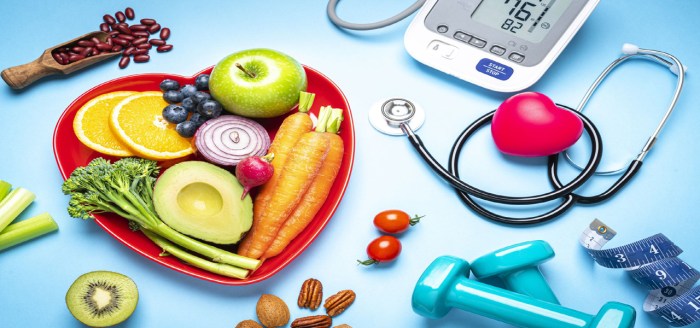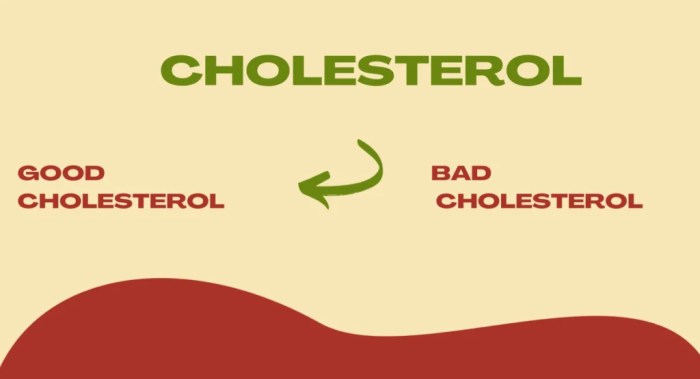Get ready to dive into the world of cholesterol management, where we break down the nitty-gritty details of keeping your health in check. From understanding what cholesterol is to exploring the impact it has on your well-being, this topic is all about empowering you to take charge of your health.
Overview of Cholesterol Management
Cholesterol is a waxy, fat-like substance found in the cells of your body. While it is essential for building cell membranes and producing certain hormones, high levels of cholesterol can lead to plaque buildup in the arteries, increasing the risk of heart disease and stroke.
Types of Cholesterol
Cholesterol is carried through the bloodstream by two types of lipoproteins: low-density lipoprotein (LDL) and high-density lipoprotein (HDL). LDL cholesterol, often referred to as “bad” cholesterol, can build up in the arteries, leading to blockages. On the other hand, HDL cholesterol, known as “good” cholesterol, helps remove LDL cholesterol from the arteries, reducing the risk of heart disease.
Importance of Cholesterol Management
Proper cholesterol management is crucial in preventing heart disease and maintaining overall health. By keeping LDL cholesterol levels in check and increasing HDL cholesterol levels through a healthy diet, regular exercise, and medication if necessary, individuals can reduce their risk of developing cardiovascular complications.
Factors Influencing Cholesterol Levels
When it comes to cholesterol levels, various factors can play a role in influencing them. These factors can range from lifestyle choices to genetic predispositions, as well as age and gender.
Lifestyle Factors
- Diet: Consuming a diet high in saturated fats, trans fats, and cholesterol can contribute to high cholesterol levels. On the other hand, a diet rich in fruits, vegetables, whole grains, and lean proteins can help lower cholesterol.
- Exercise: Regular physical activity can help raise HDL (good) cholesterol levels and lower LDL (bad) cholesterol levels. It also helps in maintaining a healthy weight, which is beneficial for cholesterol management.
Genetic Predispositions
Genetics can also play a significant role in cholesterol levels. Some individuals may have a genetic predisposition to high cholesterol, making it more challenging to manage through lifestyle changes alone.
Age and Gender Influence
- Age: Cholesterol levels tend to increase with age, as the body’s metabolism slows down. It’s essential for older individuals to monitor their cholesterol levels regularly and make necessary adjustments to their lifestyle.
- Gender: Before menopause, women typically have lower cholesterol levels than men. However, after menopause, women’s cholesterol levels may rise, equalizing with or even surpassing men’s levels.
Dietary Strategies for Managing Cholesterol
To help manage cholesterol levels, it’s important to focus on making heart-healthy dietary choices. Certain foods can help lower LDL (“bad”) cholesterol, while others can raise HDL (“good”) cholesterol, providing a good balance for overall heart health.
Foods that can help lower LDL (“bad”) cholesterol
Include a variety of the following foods in your diet:
- Oats: Oats contain beta-glucans, a type of soluble fiber that can help lower LDL cholesterol levels.
- Nuts: Almonds, walnuts, and other nuts are rich in healthy fats, fiber, and plant sterols that can reduce cholesterol.
- Fatty Fish: Salmon, mackerel, and sardines are high in omega-3 fatty acids that can help lower triglycerides and increase HDL cholesterol.
- Avocado: Avocados are a great source of monounsaturated fats that can improve cholesterol levels.
- Legumes: Beans, lentils, and chickpeas are high in soluble fiber, which can help lower cholesterol.
Role of fiber and healthy fats in cholesterol management
Fiber and healthy fats play a crucial role in managing cholesterol levels:
- Fiber: Soluble fiber found in fruits, vegetables, whole grains, and legumes can help lower LDL cholesterol by reducing cholesterol absorption in the bloodstream.
- Healthy Fats: Monounsaturated and polyunsaturated fats found in olive oil, avocados, nuts, and seeds can help lower LDL cholesterol and reduce inflammation in the body.
Reading food labels to make heart-healthy choices
When reading food labels, focus on the following:
- Saturated Fat: Limit foods high in saturated fats, as they can raise LDL cholesterol levels. Look for products with low saturated fat content.
- Trans Fat: Avoid trans fats, as they can increase LDL cholesterol and lower HDL cholesterol. Check for “partially hydrogenated oils” in the ingredients list.
- Cholesterol: Choose foods low in cholesterol to help manage your overall cholesterol intake.
- Fiber: Opt for foods high in fiber to aid in cholesterol reduction. Look for products with at least 3 grams of fiber per serving.
Physical Activity and Cholesterol

Regular physical activity plays a crucial role in managing cholesterol levels and overall heart health. Exercise can help raise HDL (good) cholesterol levels while lowering LDL (bad) cholesterol levels, reducing the risk of heart disease.
Impact of Exercise on Cholesterol Levels
Regular aerobic exercises such as brisk walking, running, swimming, or cycling can help increase HDL cholesterol levels and lower LDL cholesterol. Strength training exercises like weightlifting can also contribute to improving cholesterol profiles by increasing muscle mass and metabolism.
Examples of Aerobic and Strength Training Exercises
- Aerobic exercises: Brisk walking, jogging, cycling, swimming
- Strength training exercises: Weightlifting, bodyweight exercises, resistance band workouts
Recommended Amount of Physical Activity
According to the American Heart Association, adults should aim for at least 150 minutes of moderate-intensity aerobic activity or 75 minutes of vigorous-intensity activity per week, along with two or more days of strength training exercises.
Medication and Treatment Options

When lifestyle changes alone are not enough to manage cholesterol levels, medication may be necessary to reduce the risk of heart disease and stroke. It is important to work closely with a healthcare provider to determine the most appropriate treatment plan.
Common Cholesterol-Lowering Medications and Mechanisms of Action
- Statins: These medications work by blocking a substance your liver needs to make cholesterol. They also help your body reabsorb cholesterol that has built up in plaques on your artery walls.
- Ezetimibe: This drug helps reduce the amount of cholesterol absorbed by your intestines.
- PCSK9 inhibitors: These medications help increase the liver’s ability to remove LDL cholesterol from the blood.
- Fibrates: Fibrates work mainly by lowering triglycerides and in some cases raise HDL cholesterol.
Importance of Regular Monitoring and Compliance
Regular monitoring of cholesterol levels is crucial to assess the effectiveness of the prescribed medication and make adjustments if necessary. It is essential to follow the treatment plan as directed by a healthcare provider to achieve optimal results and reduce the risk of complications associated with high cholesterol.
Lifestyle Changes for Cholesterol Management
When it comes to managing cholesterol levels, making lifestyle changes can play a significant role in improving your overall health. Here are some tips and strategies to help you make positive changes in your daily routine.
Tips for Quitting Smoking
- Avoid triggers that make you want to smoke, such as certain places or activities.
- Seek support from friends, family, or a support group to help you stay motivated.
- Consider nicotine replacement therapy or other medications to help with withdrawal symptoms.
Role of Stress Management, Cholesterol management
- Practice relaxation techniques like deep breathing, meditation, or yoga to reduce stress levels.
- Engage in physical activity, which can help release endorphins and improve mood.
- Seek professional help if stress becomes overwhelming or unmanageable.
Strategies for Maintaining a Healthy Weight
- Eat a balanced diet rich in fruits, vegetables, whole grains, and lean proteins.
- Avoid processed foods high in saturated fats, sugar, and sodium.
- Stay active by incorporating regular exercise into your routine, such as walking, jogging, or strength training.

